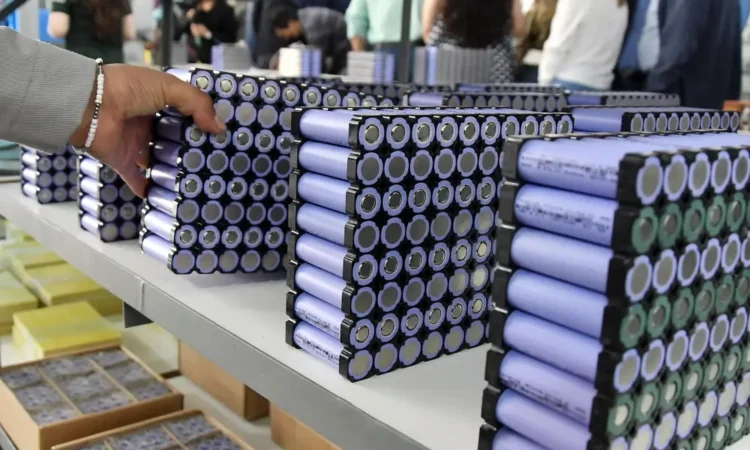Table of Contents
What AI has discovered?
Using artificial intelligence and supercomputing technology, a new material has been discovered that can reduce the use of lithium in batteries. The research was carried out by Microsoft and the Pacific Northwest National Laboratory (PNNL), which is part of the US Department of Energy. Scientists say, that with the help of this new material, the use of lithium in batteries can be reduced by up to 70 per cent. The BBC reports that it is possible to light the lightbulb with batteries made of new materials. Microsoft researchers used AI technology and supercomputers to search for new material, where 18 potential ones were selected from 32 million possible inorganic materials in less than a week.
Image credit: Microsoft
The screening process would have taken more than two decades if conventional methods of lab research had been carried out. Its viable battery prototype took less than nine months from the conceptual stage to development. The two institutions have achieved this goal by using advanced artificial intelligence as well as high-end computing technology, where many computers are integrated to solve various complex scientific and mathematical tasks.
Microsoft’s executive vice president, Jason Zander, told the BBC that the company’s mission was to “put two and a half years of scientific research into action over the next 25 years”. “We think such technology will help us a lot. And such scientific findings can be worked on in the future as well.” He said.
About Lithium and its other details:
Part 1:
Lithium problems Lithium is sometimes called ‘white gold’ due to its market value and silver colour. It is a very important element in the production of ‘rechargeable batteries (lithium-ion batteries)’, which have been used in everything from electric cars or EVs to smartphones. As the demand for EVs increased, so did the need for metals. According to the International Energy Agency (IEA), there could be a metal shortage in the world by 2025.
According to the US Department of Energy, the demand for lithium-ion batteries may increase 10 times by the year 2030, which is why manufacturing companies are setting up battery factories to meet them. In addition, lithium extraction is also somewhat controversial as it takes several years and also has a large impact on the environment. Refining such metals also consumes a large amount of water and energy. Apart from causing major damage to the surface, toxic waste is also generated through this process.
Part 2:
The main researcher of the battery research team in the chemistry department of Imperial College London. Nuria Tapia-Ruiz said reducing the amount of lithium metal and using any material with it would be considered the “holy grail” or golden key of the lithium-ion battery industry. “AI and supercomputing technologies are likely to be important for battery researchers in the coming years, with the potential to make predictions about different effective materials.” He said.
However, the lecturer of the chemical engineering department of the University of Strathclyde Dr Edward Brightman says that this technology should be used “with some caution”. “There is a risk of showing fake or good-looking results at first. And there is also the risk of using known ingredients that cannot be tested in the lab.” He said.
How is AI different?
This technology works through a new type of artificial intelligence system developed by Microsoft. It is trained on molecular data, which can trace the basic chemistry of the material. “This artificial intelligence system is built based on various scientific materials and databases.” — said Xander.
This data is very reliable in conducting scientific research.” After the software selected 18 components, PNNL’s battery experts tested it in the lab and selected the final component, BBC reported. Karl Mueller, a researcher at PNNL, said that with the help of Microsoft’s AI system, they were able to achieve “results much faster” than conventional systems. In addition to testing the chemical properties of the new material, we were also able to quickly assess whether it could be used in batteries. This indicates how advanced AI technology can speed up the innovation cycle.”
Conclusion:
In a world racing against the clock to develop long-term answers, the convergence of AI and high-performance computing is a beacon of hope. Microsoft’s commitment to condensing millennia of scientific learning into decades is in line with the importance of our environmental concerns. As we enter a new era of scientific discovery, a partnership between technology behemoths and academic institutions holds the key to a future that is more environmentally friendly.
Source credit: BD News and Analytics Vidhya
Thumbnail credit: Business Insider
- FASTag KYC update: Updation of KYC for FASTag before 31st January; Step-by-step Process:
- Tejas vs. Thunder: China’s “Wrestles,” JF-17 With a fighter deal with Nigeria, India’s LCA Tejas is fully engaged in backchannel diplomacy.
- Real Madrid Victory: At Las Palmas, Aurelian Tchouameni gives Real Madrid a late victory.
- Bharat Ratna: Must-know Facts and Important FAQs on the Bharat Ratna Award
- Klopp is leaving Liverpool at the end of the season
